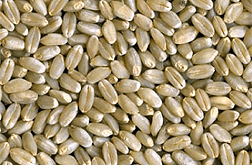This page has been archived and is being provided for reference purposes only. The page is no longer being updated, and therefore, links on the page may be invalid.
|
|
|
|
New Winter Wheat Ready for Prime Time
By Jan SuszkiwDecember 31, 2008
Anton, a hard white winter wheat cultivar developed by Agricultural Research Service (ARS) and University of Nebraska (UN) scientists, is now available for production in the Northern Plains region as a source of high-quality flour for bread, noodles and other baked goods.
Anton is the product of 15 years of selective breeding and evaluation by scientists with ARS' Grain, Forage and Bioenergy Research Unit and UN's Nebraska Agricultural Experiment Station (NAES), both at Lincoln, Neb.
ARS plant geneticist Robert Graybosch collaborated with NAES small-grains breeder Stephen Baenziger and others to develop Anton as a wheat cultivar with reduced levels of the enzyme polyphenol oxidase (PPO). This enzyme is found in many plants, fruits and vegetables, and leads to biochemical reactions that cause browning. In wheat, low PPO levels correlate to improved end-use quality, especially color in noodles. White wheat flour also has a milder flavor than red wheat flour, such as in whole-grain breads.
Anton is the "top pick" of four generations of offspring plants derived from crosses between the commercial cultivar Platte and two wheat breeding lines, WA691213-27 and N86L177. During 2003-2004 evaluations at ARS' Northern Regional Performance Nursery in Nebraska, Anton's grain yields were similar to those of Nuplains and Nekota (two white winter wheats), but lower than yields of the red winter wheat Darrell.
During 2007 trials conducted by NAES, Anton averaged 50 bushels per acre compared to 57, 53 and 54 bushels for, respectively, Millennium, Jagalene and Wesley, Nebraska's top three winter wheats. In end-use trials, though, Anton scored higher on mixograph tests, which measure dough-gluten strength and resistance to breakdown when rolled with pins. Anton's lower PPO levels also meant noodles made from its flour sustained fewer color and brightness changes during a 24-hour evaluation period.
Anton grows to about 31 inches tall. It is somewhat resistant to stem and leaf rust diseases, moderately susceptible to stripe rust, and tolerates wheat soilborne mosaic virus.
UN's Foundation Seed Division is handling requests for seeds of Anton.
ARS is a scientific research agency of the U.S. Department of Agriculture.

